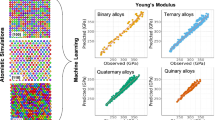Abstract
Alloy design is critical to achieving the target performance of industrial components and products. In designing new alloys, there are multiple property requirements, including mechanical, environmental, and physical properties, as well as manufacturability and processability. Computational models and tools to predict properties from alloy compositions and to optimize compositions for multiple objectives are essential in enabling efficient, robust alloy design. Data-driven property models by machine learning (ML) are particularly useful in predicting physical properties with relatively simple dependence on composition, and in predicting complex properties that are too difficult for a physics-based model to achieve with desirable accuracy. In this article, we describe examples of ML applications to model coefficient of thermal expansion, creep and fatigue resistance in designing Ni-based superalloys, and optimization methodologies. We also discuss physics-based microstructure models that have been developed for optimizing heat-treatment conditions to achieve desired microstructures.




Similar content being viewed by others
References
T.M. Pollock, J.E. Allison, D.G. Backman, M.C. Boyce, M. Gersh, E.A. Holm, R. LeSar, M. Long, A.C. Powell IV, J.J. Schirra, D.D. Whitis, C. Woodward, Integrated Computational Materials Engineering: A Transformational Discipline for Improved Competitiveness and National Security (National Research Council, National Academies Press, Washington, DC, 2008).
T.M. Pollock, S. Tin, J. Propul. Power 22, 361 (2006).
R.C. Reed, The Superalloys: Fundamentals and Applications (Cambridge University Press, Cambridge, UK, 2006).
R. Darolia, Int. Mater. Rev. (2018), doi.org/10.1080/09506608.2018.1516713.
A. Suzuki, M.F.X. Gigliotti, B.T. Hazel, D.G. Konitzer, T.M. Pollock, Metall. Mater. Trans. A 41, 947 (2010).
S. Patil, S. Huang, M. Karadge, D. Konitzer, A. Suzuki, in Superalloys 2016, M. Hardy, Ed. (Wiley, Hoboken, NJ, 2016), p. 959.
R.C. Reed, T. Tao, N. Warnken, Acta Mater. 57, 5898 (2009).
R.E. Schafrik, Metall. Mater. Trans. B 47, 1505 (2016).
C.E. Guillaume, Nature 71, 134 (1904).
G. Bozzolo, M.F. del Grosso, H.O. Mosca, Mater. Lett. 62, 3975 (2008).
D. Kim, S.-L. Shang, Z.-K. Liu, Acta Mater. 60, 1846 (2012).
M. van Schilfgaarde, I.A. Abrikosov, B. Johansson, Nature 400, 46 (1999).
M.S.A. Karunaratne, S. Kyaw, A. Jones, R. Morrell, R.C. Thomson, J. Mater Sci. 51, 4213 (2016).
P.K. Sung, D.R. Poirier, Mater Sci. Eng. A 245, 135 (1998).
N. Bano, M. Nganbe, J. Mater. Eng. Perform. 22, 952 (2013).
F. Pedregosa, G. Varoquaux, A. Gramfort, V. Michel, B. Thirion, O. Grisel, M. Blondel, P. Prettenhofer, R. Weiss, V. Dubourg, J. Vanderplas, A. Passos, D. Cournapeau, M. Brucher, M. Perrot, É. Duchesnay, J. Mach. Learn. Res. 12, 2825 (2011).
S. Raschka, J. Open Source Softw. 3, 638 (2018).
A. Srivastava, A.K. Subramaniyan, L. Wang, ASME Turbo Expo 2015 (ASME, New York, 2015) p. GT2015–43693.
N.C. Kumar, A.K. Subramaniyan, L. Wang, ASME Turbo Expo 2012 (ASME, New York, 2012) p. GT2012–69058.
C. Shen, A. Suzuki, D.G. Konitzer, in Superalloys 2016, M. Hardy, Ed. (Wiley, Hoboken, NJ, 2016) p. 259.
C. Shen, in Modeling Long-Term Creep Performance for Welded Nickel-Base Superalloy Structures for Power Generation Systems (2017), doi:10.2172/1345084.
C. Shen, in Modeling Creep-Fatigue-Environment Interactions in Steam Turbine Rotor Materials for Advanced Ultra-Supercritical Coal Power Plants (2014), doi:10.2172/1134364.
J.-C. Zhao, Prog. Mater. Sci. 51, 557 (2006)
Author information
Authors and Affiliations
Corresponding author
Rights and permissions
About this article
Cite this article
Suzuki, A., Shen, C. & Chennimalai Kumar, N. Application of computational tools in alloy design. MRS Bulletin 44, 247–251 (2019). https://doi.org/10.1557/mrs.2019.70
Published:
Issue Date:
DOI: https://doi.org/10.1557/mrs.2019.70




